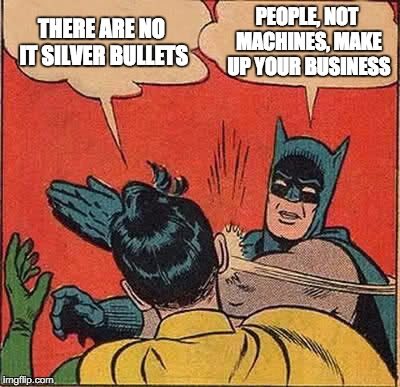Every year the Dell Global Technology Adoption Index shows that more and more companies are embracing technology to change how they operate and improve performance. But it ain’t what you do, it’s the way that you do it that matters. There are no ‘silver bullets’ in IT that you can just fire to solve all your problems instantly.
Companies that use technology well see better results. Organisations actively using cloud, mobility and big data technologies are experiencing up to 53 percent higher revenue growth than those that aren’t.
Technology is changing the professional world and how we work for the better, and it’s a great tool for businesses looking to improve productivity, efficiency and performance.
Silver bullets are magical thinking
However, when it comes to solving critical business problems, using IT as a sticking-plaster solution merely treats the symptoms – not the cause. Here’s why:
- IT is only part of the solution. It takes time, commitment and investment to deploy and use technology successfully. You can implement the best tools available, but they’ll only work if they fit your business practices and meet your employees’ needs. A solution that only solves part of the problem is not really a solution at all.
- There are limits to how much IT can do. Most businesses turn to technology to improve productivity, efficiency and communication. Many also use it to make the workplace more flexible for staff and clients. But while technology is great for solving certain logistical problems, it can’t fix everything. You need to address the underlying issues and look at the deeper causes of problems before you turn to technology.
- People, not machines, make up your business. Even the most automated factory lines have human employees, not to mention human customers. Your company culture, employees and clients have a huge impact on communication practices, productivity and general business performance. Without the right mindset, training and skills, technology can only do so much for them.
In a nutshell, technology is a tool to help you solve problems. It’s not a solution on its own.
Identify problems first, then consider IT
Defining and understanding business problems is the first step towards solving them. You need to unearth underlying causes and look at whom the problem affects.
Often it can help to get an outside, objective view. It’s common practice to bring in growth or management consultants, and the same should be true for IT. You want to work with a partner that asks questions before they make suggestions.
Defining problems requires patience and time, but it’s critical if you want to be sure that you’re solving your problems the right way and investing smartly in the right solutions. When confronted with a problem take a leaf from the book of Toyota and ask yourself:
- How is this problem affecting my colleagues and my business? Describing the problem and the context will help you understand why and how people are being impacted.
- What is the problem? After you’ve described the problem, try to capture it in a simple, concise definition.
- Why is this a problem? This is the most important question. Taiichi Ohno, father of the Toyota Production System, believed that the best way to explore problems is by asking ‘why.’ Ask yourself this question repeatedly until you feel you’ve identified the source issue.
Ask the right questions
Renowned engineer and author, W. Edwards Deming, believed that ‘if you do not know how to ask the right question, you discover nothing.’ For Dr. Deming, asking more abstract, high-level questions can help you solve problems. These may include:
- What business are we in?
- What business ought we be in?
- What will we be doing a year from now, 5 years from now, 10 years from now?
The point of these simple questions is to get you to think more openly about your business, the nature of your business problems, and what your true objectives are. When you begin to understand these, you can better see how IT can support your decision-making.
Though technology has revolutionised the workplace and certainly helps us be more productive, efficient and connected, it’s not the answer to all your business problems. Whatever you do, make sure that you’re asking the right questions and solving the right problems before you invest in technology.



